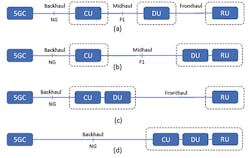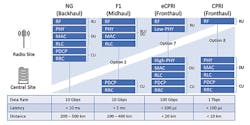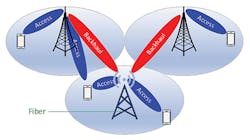Latest from 5G/6G & Fixed Wireless Access/Mobile Evolution
IAB, HFC, PON, Radio-over-Ethernet, and WDM, Join the Backhaul Game —
There were approximately 82 5G networks around the world as of summer 2020, a number that’s expected to grow to 206 by the end of 2020. As 5G networks continue to expand, so will the density of cell sites needed to power them. Furthermore, the growth of 5G by enterprise and consumer growth is robust with 5G connections expected to grow to well over 1 billion by the end of 2023.
When it comes to building networks, there are many things to consider. Some of these include power, capacity, and overall data throughput demand. According to Ericsson, global total mobile data traffic will grow by a factor of 4 between the end of 2019 to 2025 — from around 38 exabytes per month in 2019 to 160 exabytes per month by the end of 2025.
InvisiLight® Solution for Deploying Fiber
April 2, 2022Go to Market Faster. Speed up Network Deployment
April 2, 2022Episode 10: Fiber Optic Closure Specs Explained…
April 1, 2022Food for Thought from Our 2022 ICT Visionaries
April 1, 2022How will wireless network operators be able to manage all of this data?
One key ingredient is having enough licensed spectrum, but the other is network densification. Network densification is the process of adding more cell sites to increase the amount of coverage and capacity on a network. In order to do so, the network must have a data connection at the cell site that brings together information that the radio access network (RAN) receives over the air from mobile devices, run through series of signal and data processing in the RAN, and managed all the way back to the core network.
To keep track of this data, network professionals use the terms backhaul, midhaul and fronthaul to designate of which parts of the network the data are connected. These designations can get challenging because there are several ways in which the 3 key elements of a RAN may be placed geographically.
These include:
1. the centralized unit (CU) housed at the central office or data center
2. the distributed unit (DU) located regionally
3. the remote unit (RU) at the cell site
Sometimes, the CU might be located with the DU and the RU, or perhaps with the DU only. Sometimes the DU and RU are located together, but separately. But roughly speaking, backhaul is anything that connects data between the core network and the CU, midhaul is anything that connects data between the CU and the DU, and fronthaul is anything that connects the DU with the RU. (See Figure 1.)
Figure 1. Different combinations of backhaul, midhaul, and fronthaul according to core and access network topology. (Source: Innovations in 5G Backhaul Technologies: IAB HFC and Fiber, 5G Americas White Paper)
Today, there are innovative ways that Integrated Access and Backhaul (IAB), Hybrid Fiber Coax (HFC), and Fiber, can be used to improve the amount of data that can be passed between the 5G core network and the 5G centralized unit.
One key thing in understanding how much backhaul is required is understanding that data transport requirements change depending on how much raw processing power is being utilized at each location in the RAN — at the CU, DU, or RU. For instance, 5G allows for the creation of functional splits in the RAN where specific processing tasks are handled by different units. The more processing that is done there, the bigger the "data pipe" needed to support it.
Ultimately, the decision to determine the functional split of the RAN is based on the underlying and future planned architecture of the network. Figure 2 shows the difference in data rates, latency, and distance, that are required for each unit of the RAN, depending on how it is arranged according to the functional split.
Figure 2. Transport requirements for 5G NR functional splits. (Source: Nokia)
Integrated Access and Backhaul
One of the key innovations in wireless backhaul is Integrated Access and Backhaul (IAB), which allows for the use of a portion of radio access spectrum to be used for backhaul as well.
Traditionally, cell sites have been connected via point-to-point dark fiber, that is, fiber optic cables which already exist in the ground or on utility poles. When that fiber isn’t available, it can be incredibly costly for network operators to deploy new fiber, which might involve complex trenching and challenging in-building obstacles. In fact, studies show that in the US alone at least $130 billion in fiber builds is required to reach the full performance that 5G promises.
IAB solves this problem by allotting some of the spectrum that would have been used by the RAN and using it to connect the CU to the core network. This technology has generated a lot of interest in the industry, since IAB is expected to provide a cost-efficient and fast time-to-market backhaul solution. IAB can use many of the great tools of spectrum management, including time, frequency, and spatial division multiplexing, to greatly enhance the efficiency of the spectrum for backhaul purposes. Additionally, network operators have many ways of using IAB, including network densification, filling coverage holes, providing on-demand coverage, and general capacity expansion. (See Figure 3.)
Figure 3. Integrated Access and Backhaul
However, care must be taken so that its use does not impact network quality due to interference or the reduction in capacity due to the complex multiplexing mechanisms used between access and backhaul.
Additional considerations must also be given to network topology, routing, quality of service (QoS), and emerging and future technologies that may reshape the way that IAB is deployed.
(At the time of this writing, IAB is standardized in 3GPP Release 16, which was to be finalized at the end of June 2020; it aims to reuse the existing 5G radio air interface for backhaul purposes.)
Additional Network Helpers
Recent advances in the HFC network, passive optical network (PON), and Ethernet technology, make these solutions equally promising options for 5G transport. Leveraging existing HFC and PON deployments significantly reduces the time-to-market and cost of deploying 5G.
Both HFC and PON are already extensively deployed in areas where 5G will be in the most demand, specifically dense urban and urban environments. North America already has several multi-gigabit shared infrastructure solutions that are already deployed virtually down every street and to every building on the continent. The first such network is the HFC network that is owned and deployed by US cable companies and reaches 93% of American households.
One critical aspect of HFC networks is the use of the new data-over-cable service interface specification DOCSIS 4.0 specification, which will allow HFC networks to deliver multi-gigabit per second capabilities. (See Figure 4.) Under an HFC/DOCSIS system the head end of a cable system is connected by feeder fiber to an optical node, which is further split by distribution coaxial cable by an RF splitter to buildings. A new technology standard called low-latency xHaul (LLX) can also dramatically reduce latency issues involving HFC networks.
Figure 4. HFC / DOCSIS Network Architecture
Overall, HFC offers several key advantages for backhaul:
• Ubiquity — HFC cables already run down virtually every street and to every home/business across North America.
• Ample Capacity — The newly released DOCSIS 4.0 specification, now promises downstream speeds over 10 Gbps. This should provide ample capacity for most 5G transport use cases.
• Power — HFC networks are active, and able to draw power "from the line" to power small cell deployments.
• Construction & Permitting — Thanks to existing strand infrastructure, cable operators can very quickly connect small cells to their existing aerial plant. Deployment of a small cell can be accomplished in a matter of an hour, by tapping into the existing coaxial strand, and attaching a line-powered, strand-mounted small cell. This eliminates the need for any permitting and dramatically accelerates deployments.
Similar to HFC networks, PONs have been extensively deployed throughout North America over the past couple of decades. PON is used to provide fiber-to-the-home and fiber-to-the-premises, and widely deployed over many urban areas. A recent analysis by Bell Labs showed that leveraging existing FTTH networks can decrease 5G transport costs by more than 50% compared to traditional solutions such as microwave and P2P dark fiber.
Over the years, improvements to PON have been developed by the International Telecommunications Union (ITU-T), which have evolved greater data rates with each iteration. Recently, the Institute of Electrical and Electronics Engineers (IEEE) has created even more PON standards.
In addition to PON, advances in Ethernet-based transport such as new radio encapsulation techniques, time-sensitive networking (TSN), and radio-over-Ethernet (RoE), are transforming 5G fronthaul networks. While Ethernet has become the de facto standard for cell site backhaul because of its low cost, multi-vendor interoperability, service flexibility, and ubiquity, using Ethernet in fronthaul networks, offers the prospect of significantly reducing the cost of C-RAN architectures. Such an architecture might look something like Figure 5.
Figure 5. Converged Ethernet xHaul Network
Finally, wavelength division multiplexing (WDM) can be applied across a broad range of technologies to meet critical 5G transport requirements. WDM is a technology that multiplexes a number of optical carrier signals onto a single optical fiber by using different wavelengths of light. This allows you to get more data through the same number of fiber strands — a very effective way to boost the efficiency of existing fiber assets.
Conclusion
Today, 5G network operators are faced with an increasing array of new choices in designing, architecting, and managing, their networks. As consumer and business use cases become more specialized and data requirements become more demanding, it will be necessary to continue to build the right kind of network to deliver the best customer experience.
Like this Article?
Subscribe to ISE magazine and start receiving your FREE monthly copy today!
Resources and Notes
• 5G Americas white paper Innovations in 5G Backhaul Technologies: IAB HFC and Fiber. https://www.5gamericas.org/innovations-in-5g-backhaul-technologies/
• A Bell Labs Consulting study. Quantifying the cost benefits of FTTH for 5G transport by Ana Pesovic, 16 Apr 2020. https://www.nokia.com/blog/quantifying-cost-benefits-ftth-5g-transport/
• Ericsson Mobility Reports. https://www.ericsson.com/en/mobility-report/reports#:~:text=Key%20findings,of%20total%20mobile%20data%20traffic.
• GT. Government Technology. Deploying 5G Will Cost at Least $130 Billion in Fiber, Study Says. By Giuseppe Macri, InsideSources.com, Washington, D.C. / July 10, 2017. https://www.govtech.com/network/Deploying-5G-Will-Cost-at-Least-130-Billion-in-Fiber-Study-Says.html














